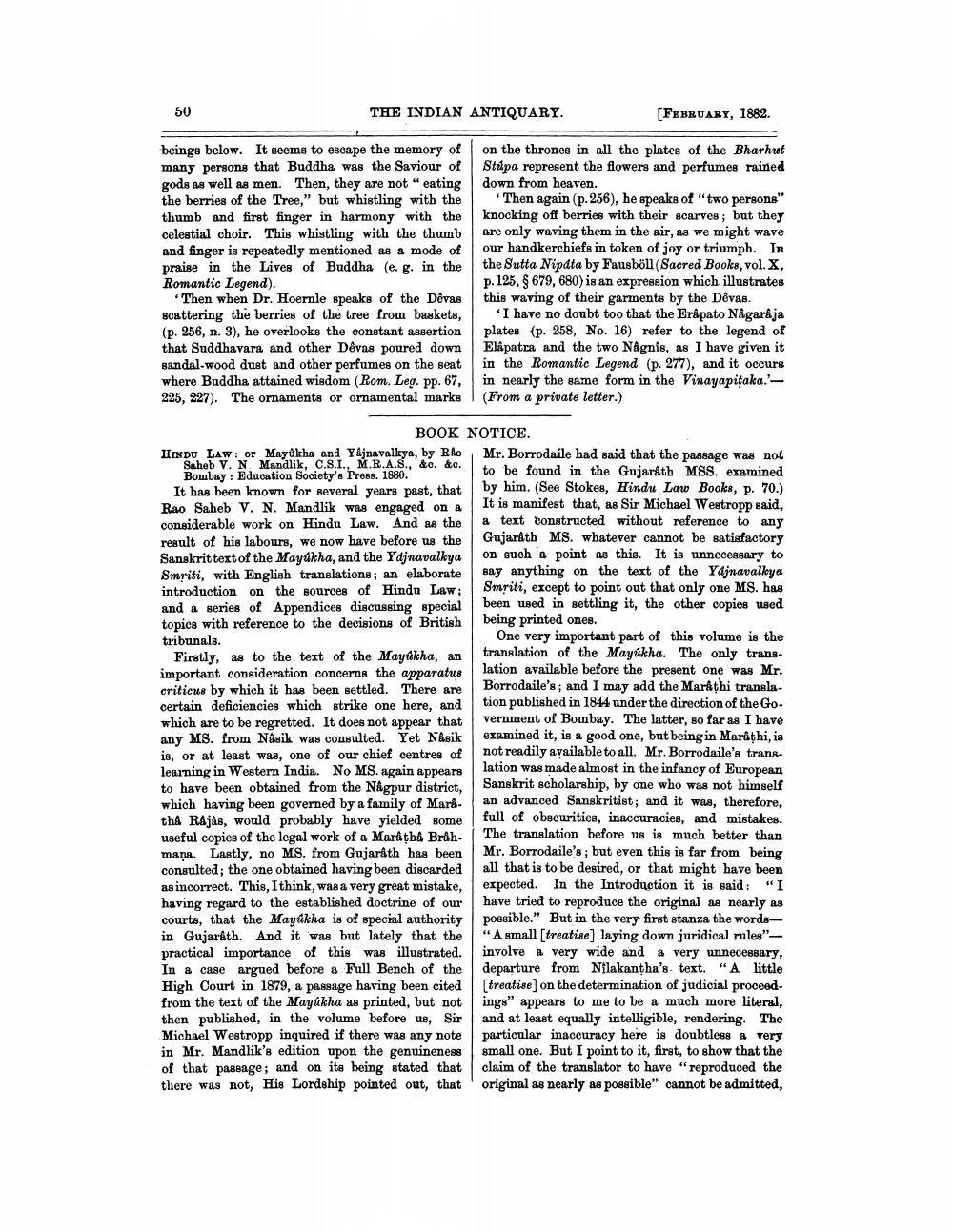________________
50
THE INDIAN ANTIQUARY.
[FEBRUARY, 1882.
beings below. It seems to escape the memory of many persons that Buddha was the Saviour of gods as well as men. Then, they are not "eating the berries of the Tree," but whistling with the thumb and first finger in harmony with the celestial choir. This whistling with the thumb and finger is repeatedly mentioned as a mode of praise in the Lives of Buddha (e. g. in the Romantic Legend).
* Then when Dr. Hoernle speaks of the Devas scattering the berries of the tree from baskets, (p. 256, n. 3), he overlooks the constant assertion that Suddhavara and other Devas poured down sandal-wood dust and other perfumes on the seat where Buddha attained wisdom (Rom. Leg. pp. 67, 225, 227). The ornaments or ornamental marks
on the thrones in all the plates of the Bharhut Stúpa represent the flowers and perfumes rained down from heaven.
Then again (p. 256), he speaks of "two persone" knocking off berries with their scarves; but they are only waving them in the air, as we might wave our handkerchiefs in token of joy or triumph. In the Sutta Nipata by Fausböll (Sacred Books, vol. X, p.125, 679, 680) is an expression which illustrates this waving of their garments by the Devas.
'I have no doubt too that the Erâpato Nagaraja plates (p. 258, No. 16) refer to the legend of Elâpatra and the two Någnis, as I have given it in the Romantic Legend (p. 277), and it occurs in nearly the same form in the Vinayapitaka.'(From a private letter.)
BOOK NOTICE. HINDU LAW: or Maykha and Yajnavalkya, by RhoMr. Borrodaile had said that the passage was not
Saheb V. N. Mandlik, C.S.I., M.R.A.S., &c. &c. Bombay: Education Society's Press. 1880.
to be found in the Gujaráth MSS. examined It has been known for several years past, that
by him. (See Stokes, Hindu Law Books, p. 70.) Rao Saheb V. N. Mandlik was engaged on a
It is manifest that, as Sir Michael Westropp said, considerable work on Hindu Law. And as the a text constructed without reference to any result of his labours, we now have before us the Gujarath MS. whatever cannot be satisfactory Sanskrit text of the Mayúkha, and the Ydjnavalkya on such a point as this. It is unnecessary to Smriti, with English translations; an elaborate say anything on the text of the Yajnavallya introduction on the sources of Hindu Law; Smriti, except to point out that only one MS. has and a series of Appendices discussing special been used in settling it, the other copies used topics with reference to the decisions of British
being printed ones. tribunals.
One very important part of this volume is the Firstly, as to the text of the Mayúkha, an
translation of the Mayúkha. The only transimportant consideration concerns the apparatus
lation available before the present one was Mr. criticus by which it has been settled. There are
Borrodaile's; and I may add the Marathi translacertain deficiencies which strike one here, and
tion published in 1844 under the direction of the Go. which are to be regretted. It does not appear that vernment of Bombay. The latter, so far as I have any MS. from Nasik was consulted. Yet Nasik examined it, is a good one, but being in Marathi, is is, or at least was, one of our chief centres of not readily available to all. Mr. Borrodaile's translearning in Western India. No MS. again appears
lation was made almost in the infancy of European to have been obtained from the Nagpur district,
Sanskrit scholarship, by one who was not himself which having been governed by a family of Mars- an advanced Sanskritist; and it was, therefore, thå Råjås, would probably have yielded some
full of obscurities, inaccuracies, and mistakes. useful copies of the legal work of a Marathé Bråh- The translation before us is much better than maņa. Lastly, no MS. from Gujarath has been Mr. Borrodaile's; but even this is far from being consulted; the one obtained having been discarded all that is to be desired, or that might have been as incorrect. This, I think, was a very great mistake, expected. In the Introduction it is said: "I having regard to the established doctrine of our have tried to reproduce the original as nearly as courts, that the Mayúkha is of special authority possible." But in the very first stanza the words in Gujarath. And it was but lately that the "A small (treatise) laying down juridical rules" practical importance of this was illustrated. involve a very wide and a very unnecessary, In a case argued before a Full Bench of the departure from Nilakantha's. text. "A little High Court in 1879, a passage having been cited treatise) on the determination of judicial proceed. from the text of the Mayúkha as printed, but not ings" appears to me to be a much more literal, then published, in the volume before us, Sir and at least equally intelligible, rendering. The Michael Westropp inquired if there was any note particular inaccuracy here is doubtless a very in Mr. Mandlik's edition upon the genuineness small one. But I point to it, first, to show that the of that passage; and on its being stated that claim of the translator to have "reproduced the there was not, His Lordship pointed out, that original as nearly as possible" cannot be admitted,




